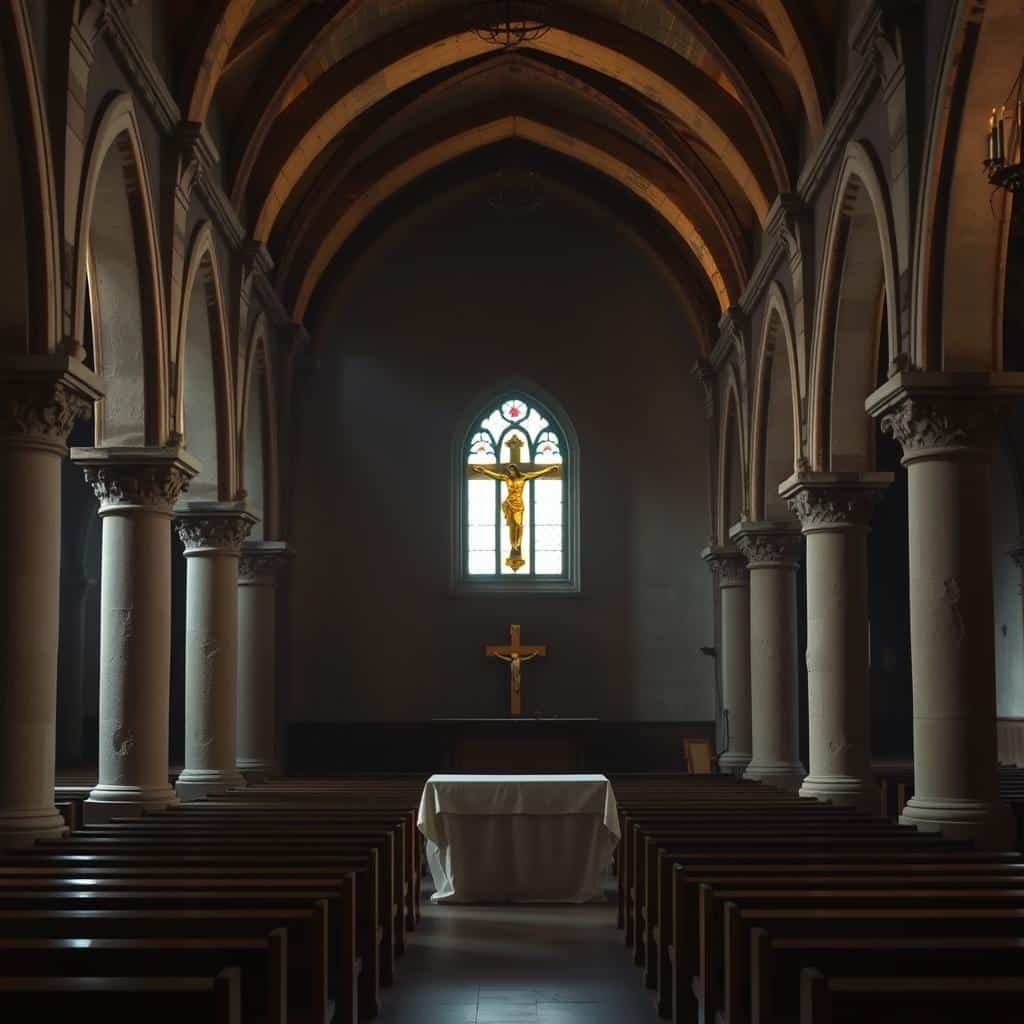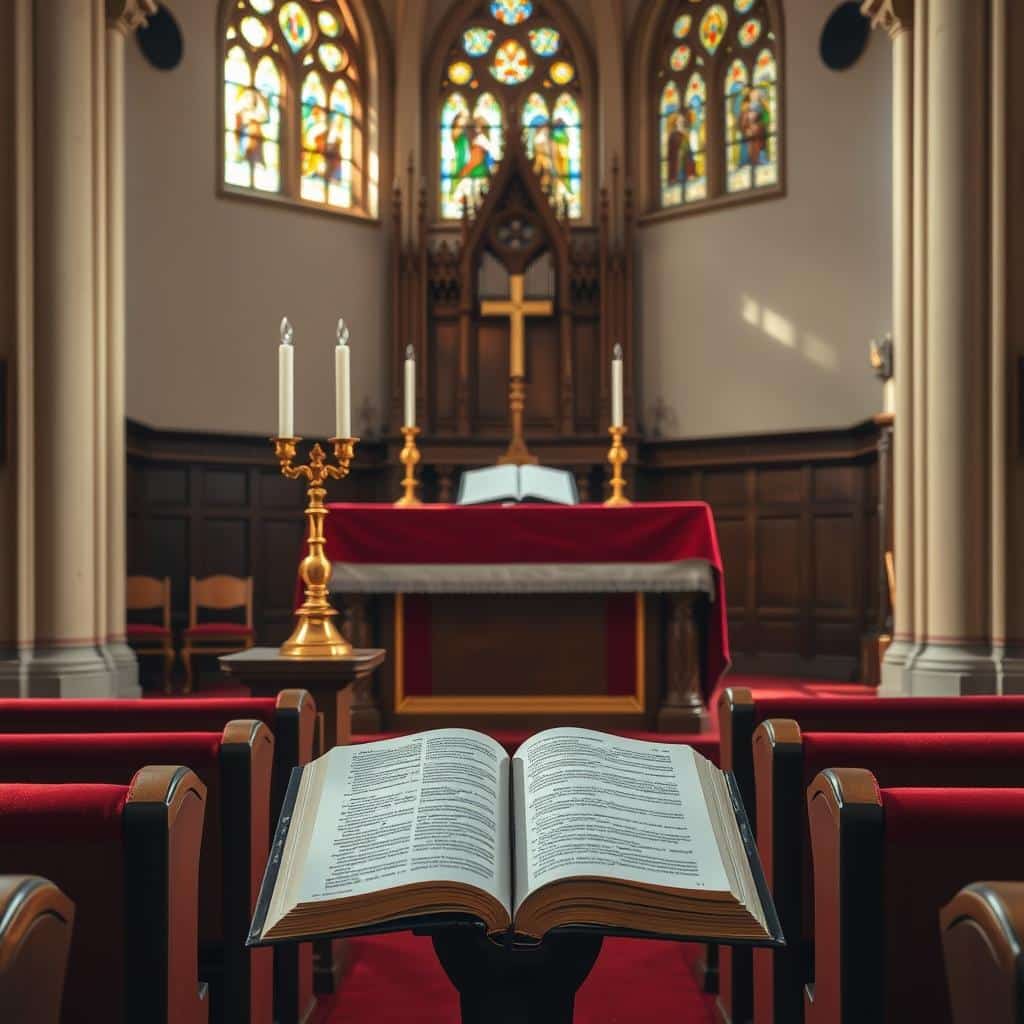Sixth Sunday of Easter Sermon – Cycle C
As we approach the end of the Easter season, the readings for the Sixth Sunday of Easter in Cycle C offer profound insights into the early Church’s journey and its relevance to our lives today.
The Gospel reading from John 14:23-29 reminds us of Jesus’ promise to send the Holy Spirit as an Advocate and teacher, guiding believers in truth and offering a unique peace that binds the Christian community together.
The first reading from Acts 15 and the second reading from Revelation further illuminate the themes of peace, love, and the guidance of the apostles by the Holy Spirit, providing a model for resolving conflicts and finding hope in divine presence.
These ancient texts speak to our modern lives, offering practical guidance for embracing the Holy Spirit’s direction and experiencing the peace that Jesus offers.
Understanding the Liturgical Context of the Sixth Sunday of Easter
In the Sixth Sunday of Easter, we find a significant moment in the Easter season. This period, spanning 50 days from Easter Sunday to Pentecost, is a time of joy and celebration, reflecting on Christ’s resurrection and its implications for our faith journey. As we journey through this season, the liturgical focus begins to shift from the resurrected Christ to the promised Holy Spirit, preparing us for the Ascension and Pentecost.
The Place of Easter Season in the Church Calendar
The Easter season is a pivotal time in the Church calendar, representing a prolonged celebration of Christ’s resurrection. It’s a period that encourages the faithful to deepen their understanding of the resurrection’s significance and its impact on their lives. As Jesus said, “If you love me, you will keep my commandments” (John 14:15). This season reminds us of the importance of living out our faith in accordance with Jesus’ teachings.
Significance of Cycle C Readings
In the three-year liturgical cycle, Year C focuses on the role of the Holy Spirit as guide and advocate, making the Sixth Sunday of Easter particularly significant. The readings for this Sunday, including Acts 15:1-2, 22-29, Revelation 21:10-14, 22-23, and John 14:23-29, create a narrative arc that guides us through the challenges of the early Church, the vision of the New Jerusalem, and Jesus’ promises to his disciples. The homily for this Sunday should help congregants connect these readings to their daily lives, emphasizing the ongoing relevance of the Spirit’s guidance.
By understanding the liturgical context of the Sixth Sunday of Easter, we can better appreciate the reading assigned for this day and its implications for our faith. As we reflect on these readings, we are reminded of the importance of trusting in God’s presence and following Jesus’ teachings, ultimately staying close to God in all that we do.
First Reading: The Jerusalem Council in Acts 15:1-2, 22-29
The Jerusalem Council, as recorded in Acts 15, marks a pivotal moment in early Church history. This event is crucial for understanding the development of the Christian faith and its expansion beyond Jewish roots.

Historical Context of the Early Church’s Challenges
The early Christian community faced numerous challenges as it grew. One of the significant issues was the integration of Gentile converts into a predominantly Jewish movement. The early Church had to navigate cultural and theological differences, ensuring that the Gospel message was preserved while being open to diverse backgrounds.
The Church in Jerusalem, led by the apostles, played a crucial role in addressing these challenges. The community’s decision-making process, guided by the Holy Spirit, set a precedent for resolving disputes in the faith community.
The Dispute Over Gentile Conversion
A critical dispute arose concerning whether Gentile converts needed to adhere to Jewish laws, including circumcision, to be fully accepted into the Christian community. This controversy threatened to divide the early Church, highlighting the tension between tradition and the inclusive nature of the Gospel.
The apostles and other leaders recognized the need to address this issue collectively, leading to the convening of the Jerusalem Council.
The Resolution and Its Significance for Today
The Jerusalem Council’s resolution, as described in Acts 15, demonstrated a balance between respecting Jewish traditions and acknowledging the Holy Spirit’s work among Gentiles. The decision to not impose circumcision on Gentile converts was pivotal, affirming their full inclusion in the faith community.
This ancient council provides a model for contemporary faith communities to address contentious issues: through respectful dialogue, attentiveness to the Spirit’s guidance, and prioritizing unity. The Council’s approach teaches us the importance of seeking the Holy Spirit’s guidance in our lives and decisions, just as the apostles did.
Responsorial Psalm: Celebrating God’s Universal Love in Psalm 67
As we reflect on the Sixth Sunday of Easter, the Responsorial Psalm, Psalm 67, invites us to celebrate God’s universal love. This psalm serves as a bridge between the first reading and the Gospel, reinforcing the theme of God’s love that extends beyond any single cultural or ethnic group.

The Theme of Divine Blessing
The psalm begins with a plea for God’s blessing, echoing the ancient Aaronic blessing. This call for divine blessing is not just for individual benefit but is envisioned as a blessing that flows outward to all peoples and nations. The psalm’s vision of the earth yielding its harvest connects divine blessing with tangible abundance, reminding us that God’s love manifests in both spiritual and material ways.
Connecting the Psalm to Easter Joy
The repeated refrain, “Let all the peoples praise you, O God; let all the peoples praise you,” creates a sense of joyful anticipation that aligns perfectly with the Easter season’s emphasis on celebration and hope. During this season, Psalm 67 takes on additional significance as we recognize that Christ’s resurrection is the ultimate blessing that God offers to all people, bringing joy that transcends cultural boundaries.
In this way, Psalm 67 not only reflects the joy and hope of the Easter season but also calls us to a broader understanding of God’s love and blessing for the world.
Second Reading: The Vision of the New Jerusalem in Revelation 21:10-14, 22-23
The vision of the New Jerusalem in Revelation is a powerful symbol of hope for Christians. It represents a future where God lives with His people, embodying the promise of eternal life and divine presence.

Symbolism of the Holy City
The New Jerusalem is described as a city coming down out of heaven from God, symbolizing the ultimate union between the divine and human realms. The city‘s twelve gates bearing the names of the twelve tribes of Israel and its twelve foundations inscribed with the names of the twelve apostles signify the continuity between God’s covenant with Israel and the new covenant in Christ. This imagery emphasizes the connection between the old and new dispensations, highlighting the fulfillment of God’s plan in Christ.
The description of the New Jerusalem is rich in symbolism, representing a reality where God’s presence is fully realized among His people. The holy spirit guides believers toward this future, filled with hope and promise.
The Absence of a Temple and Its Meaning
One of the most striking aspects of the New Jerusalem is the absence of a temple. This signifies that God’s presence is no longer confined to a specific sacred place but permeates the entire city. The text explicitly states that “God and the Lamb are its temple,” indicating a radical reimagining of sacred space. This challenges believers to recognize God’s presence in all aspects of life, not just in designated holy areas.
God’s Light Illuminating Our Lives
The New Jerusalem has no need for sun or moon because “the glory of God is its light, and its lamp is the Lamb.” This image connects powerfully with the Easter theme of Christ as the light that overcomes darkness. The holy spirit illuminates our understanding and guides our path, offering hope in a world filled with challenges. For believers, this vision offers a profound promise that despite the darkness experienced in our world, we are moving toward a reality where God’s presence and light will be all-encompassing, guiding us toward the truth.
Gospel Reading: Jesus’ Promise of the Holy Spirit in John 14:23-29
As we reflect on the Sixth Sunday of Easter, the Gospel reading from John 14:23-29 offers profound insights into Jesus’ promise of the Holy Spirit. This passage is part of Jesus’ farewell discourse at the Last Supper, where He prepares His disciples for His departure and the challenges they will face.

The Context of the Last Supper Discourse
The Last Supper discourse, as recorded in John 14-17, is a critical moment in Jesus’ ministry. Here, Jesus addresses His disciples, offering them comfort and guidance as they navigate the impending loss of their Master. The context is one of transition, as Jesus is about to leave His disciples and entrust them with the mission of spreading His teachings.
In John 14:23-29, Jesus emphasizes the importance of love and obedience. He states, “Whoever loves me will keep my word, and my Father will love him, and we will come to him and make our dwelling with him.” This underscores the reciprocal nature of love and obedience in the Christian faith.
Jesus’ Promise of the Advocate
A central theme in this passage is Jesus’ promise of the Holy Spirit as Advocate or Paraclete. Jesus assures His disciples that they will not be left alone but will receive divine guidance and teaching. The Holy Spirit will remind them of all that Jesus has taught, providing them with the wisdom and courage needed to fulfill their mission.
This promise is a source of comfort and strength for believers, reminding us that we are not abandoned in our journey of faith. The Holy Spirit acts as a divine helper, guiding us in our understanding and application of Jesus’ teachings.
The Gift of Peace “Not as the World Gives”
Jesus also offers His disciples a gift of peace, distinguishing it from the peace that the world gives. “Peace I leave with you; my peace I give to you. Not as the world gives do I give it to you,” Jesus says. This peace is not merely the absence of conflict but a positive presence that sustains believers even in turmoil.
Jesus’ instruction, “Do not let your hearts be troubled or afraid,” acknowledges the disciples’ anxiety while offering the antidote of trust in His promises. This peace calms our hearts and minds, helping us remain calm even in challenging times.
As we reflect on Jesus’ promises, we are reminded of the love that underpins our faith. By following Jesus’ teachings, we demonstrate our love for Him and grow closer to Him. The peace He offers is a profound gift that transcends understanding, a testament to the enduring nature of His peace.
The Sixth Sunday of Easter Homily – Cycle C: Core Themes
The homily for the Sixth Sunday of Easter in Cycle C delves into the heart of Jesus’ teachings, highlighting the connection between love, obedience, and the Holy Spirit’s guidance. Jesus says in today’s gospel that an advocate, the Holy Spirit, will be sent to us to teach us everything we need to know, to show us how we are to love in a flawed world.

Love as Obedience to God’s Word
At the heart of the Sixth Sunday of Easter homily lies Jesus’ profound teaching that authentic love is expressed through obedience to God’s word. This is not about burdensome rule-following but is a natural response to divine love. When Jesus says, “Whoever loves me will keep my word,” he establishes that our actions reveal the true nature of our love; we cannot claim to love God while disregarding his teachings and commands.
This obedience isn’t meant to be grudging compliance but a joyful alignment of our will with God’s, recognizing that his commands are designed for our flourishing and the well-being of the community. It’s about loving one another as Jesus has loved us, which helps us navigate the complexities of human relationships with wisdom, patience, and sacrificial love.
The Holy Spirit as Teacher and Guide
The Holy Spirit’s role as teacher and guide emerges as a central theme, showing that God doesn’t simply give us commands and leave us to figure them out alone but provides ongoing guidance through the Spirit. Jesus promises that the Holy Spirit “will teach you everything and remind you of all that I told you,” indicating both new insights and reinforcement of what has already been revealed.
This teaching function of the Holy Spirit operates both individually in the hearts of believers and collectively through the Church’s discernment. The Spirit guides us to love one another as Jesus has loved us, helping us apply God’s love in specific situations we face daily. A homily on these themes should emphasize that the Holy Spirit’s guidance isn’t abstract or theoretical but practical and personal.
The Promise of Divine Dwelling: God Making a Home With Us
The idea that God dwells with us is a transformative truth that changes everything. As Jesus says in today’s gospel, “If anyone loves me, he will keep my word, and my Father will love him, and we will come to him and make our dwelling with him.” This promise represents one of the most intimate and transformative aspects of Christian faith—the indwelling presence of God in the lives of believers.

What It Means for God to Dwell With Us
The Greek word for “dwelling” (monē) suggests permanence—God doesn’t visit temporarily but establishes a lasting home within those who love and obey him. This creates a profound intimacy between Creator and created. As St. Noel exists as a parish community to proclaim that God is real and that God is with us, we are reminded that this divine indwelling isn’t merely a theological concept but a lived reality.
It transforms our understanding of ourselves as temples of the Holy Spirit and sacred vessels of God’s presence. This indwelling presence fulfills the promise of Emmanuel, “God with us,” and represents the culmination of God’s covenant relationship with humanity that has evolved throughout salvation history.
Recognizing God’s Presence in Daily Life
Recognizing God’s presence in daily life requires intentional awareness and spiritual sensitivity—the ability to perceive the sacred within the ordinary moments of our day. The Holy Spirit helps us develop this awareness, opening our eyes to see God’s hand in nature, in human kindness, in moments of beauty, and even in our struggles and challenges.
Practical spiritual practices like contemplative prayer, gratitude journaling, and mindful attention to the present moment can help us cultivate a greater awareness of God’s dwelling presence. When we truly grasp that God makes his home with us, it transforms how we view ourselves, others, and the world around us—everything becomes potentially sacred, a place where God’s love might be encountered.
Understanding Jesus’ Peace in a Troubled World
In a world filled with turmoil, Jesus offers a peace that transcends understanding. This peace is not just a personal gift to make us feel calm and reduce our worries, but a call to make peace a greater reality in our world. Jesus gives us his peace so that we can be peacemakers in our families, treating the people in our lives with the respect and dignity they deserve.

Distinguishing Between Worldly and Divine Peace
Jesus makes a crucial distinction when he says, “Peace I leave with you; my peace I give to you. Not as the world gives do I give it to you,” inviting us to understand peace in a radically different way than our culture typically defines it. Worldly peace often means merely the absence of conflict or a temporary truce, while divine peace (shalom) encompasses wholeness, right relationship, justice, and well-being that persists even amid external turmoil.
Finding Christ’s Peace Amid Life’s Challenges
Finding Christ’s peace amid life’s challenges doesn’t mean escaping difficulties but facing them with the confidence that comes from knowing God’s presence remains with us through every trial. Jesus’ command, “Do not let your hearts be troubled or afraid,” acknowledges that maintaining peace is partly our responsibility—we must actively choose to trust his Jesus promises rather than surrendering to anxiety. Practical way to cultivate Christ’s peace include regular prayer and meditation on Scripture.
By distinguishing between worldly and divine peace, we can better understand Jesus’ gift and learn to cultivate it in our daily lives, even in times of trouble.
The Holy Spirit as Advocate: Our Divine Helper
Jesus’ promise of the Holy Spirit as Advocate is a gift that continues to guide and support us today. The term “Advocate” or “Paraclete” encompasses a rich array of roles, including counselor, comforter, encourager, helper, and defender—someone who comes alongside us in our journey of faith. This promise is particularly significant as it highlights the Holy Spirit’s role in our lives, providing us with the strength and wisdom needed to navigate life’s challenges.

The Role of the Advocate in Christian Life
The Holy Spirit, as our Advocate, teaches us “everything” and reminds us of Jesus’ words, serving as both a revealer of new insights appropriate to our time and a faithful guardian of the truth already revealed. This dual function ensures that Christian faith remains both dynamic and rooted, able to address contemporary challenges while maintaining continuity with apostolic teaching. The Spirit’s guidance is not limited to major life decisions but extends to everyday interactions, helping us respond to others with patience, kindness, and wisdom that surpasses our natural capabilities.
Recognizing the Spirit’s Guidance Today
Recognizing the Spirit’s guidance today requires developing spiritual discernment—the ability to distinguish between our own thoughts and desires and the authentic promptings of the Holy Spirit. The Spirit typically guides us through Scripture, prayer, the wisdom of the Christian community, circumstances, and an inner sense of peace about a particular direction. By being attentive to these means of guidance, we can deepen our understanding of God’s will for us and live out our faith more authentically in our daily lives.
In essence, the Holy Spirit as our Advocate is a divine helper who empowers us to live out Jesus’ teachings in our lives today. By embracing this gift, we can navigate life’s complexities with greater faith, hope, and love.
Applying the Lessons of the Early Church to Modern Challenges
As we navigate modern challenges, the early Church’s experiences and decisions remain remarkably relevant today. The story of the Jerusalem Council in Acts 15 provides a valuable model for addressing conflicts and disagreements within the church and broader society.

Learning from the Jerusalem Council’s Approach to Conflict
The early Church leaders demonstrated several key principles in their handling of disputes. They listened carefully to different perspectives, grounded their discussions in both experience and Scripture, deliberated together, and claimed the guidance of the Holy Spirit. This approach allowed them to balance respect for tradition with openness to the Spirit’s new work, offering a middle path between rigid traditionalism and uncritical acceptance of new ideas.
For people facing similar challenges today, this example is particularly relevant. Issues around inclusion, cultural adaptation, and maintaining unity amid diversity of thought and practice continue to test the church’s resolve and character.
Building Unity While Respecting Diversity
Building unity while respecting diversity requires recognizing the distinction between essential matters of faith and secondary issues where legitimate differences can coexist within the community. The early Church’s decision to require only a few essential practices from Gentile believers demonstrates a willingness to distinguish between cultural traditions and core faith commitments.
This approach encourages us to ask what truly constitutes the center of our faith and what might be cultural accretions that, while meaningful to some, should not be imposed on all believers. By doing so, we can work towards unity by listening to one another and seeking common ground, thereby building a stronger community of faith that values respect and cooperation.
At this time, as we reflect on the early Church’s example, we are reminded that diversity is not a threat to unity but a reflection of the Spirit’s work across different cultures and contexts, enriching the church’s witness rather than diminishing it. As part of this community, we are called to embrace this diversity, fostering an environment where people can come together in faith and harmony.
Practical Ways to Live Out This Sunday’s Message
As we celebrate the Sixth Sunday of Easter, we are invited to deepen our understanding of Jesus’ gift of peace and how it can transform our lives and the lives of those around us. The readings for this Sunday offer us a roadmap to living a life characterized by love and guided by the Holy Spirit. We are called to be peacemakers, influencing our families, friends, and communities to promote understanding and the common good.

Cultivating Peace in Our Relationships
Cultivating peace in our relationships begins with embracing Jesus’ model of peace—not avoiding conflict but addressing it with love, patience, and a commitment to understanding others’ perspectives even when we disagree. Practical steps include practicing active listening, using “I” statements, seeking to understand before being understood, and being willing to forgive as we have been forgiven. In family relationships, prioritizing peace involves establishing regular times for open communication and modeling conflict resolution that respects the dignity of each person.
Opening Ourselves to the Holy Spirit’s Guidance
Opening ourselves to the Holy Spirit’s guidance involves creating space in our busy lives for silence and receptivity. Developing a regular prayer practice that includes listening as well as speaking is crucial. We can become more attentive to the Spirit by studying Scripture with an open heart and participating in spiritual community. The Holy Spirit often guides us through our deepest desires when they’re aligned with God’s purposes, so examining what brings us true joy and peace can reveal divine direction.
Becoming Bearers of God’s Light
Becoming bearers of God’s light means allowing the truth, love, and peace we’ve received to shine through our actions and attitudes, becoming visible witnesses to God’s presence in the world. This involves identifying the unique gifts and opportunities God has given each of us and intentionally using them to bring hope and healing to others. Simple practices like speaking words of encouragement, performing acts of kindness, and choosing hope over cynicism all help us reflect God’s light. When we love one another as Christ has loved us, we become living testimonies to the reality of the divine dwelling promised in today’s Gospel—God making his home with and within us.
Carrying Easter Joy Forward: The Journey Continues
The Sixth Sunday of Easter serves as a poignant reminder that the peace and joy we experience during Easter should permeate our everyday existence. As we approach the end of the Easter season, we’re encouraged to carry the joy of Easter into our daily lives through the ongoing presence of the Holy Spirit.
The readings today have shown us that the risen Christ continues to dwell with his people through the Holy Spirit, offering peace that transcends understanding and guidance for our journey. This Sunday serves as a bridge between the celebration of Christ’s resurrection and the anticipation of Pentecost, inviting us to prepare our hearts for a renewed outpouring of the Spirit in our lives and communities.
As we leave today’s celebration, we carry with us the commission to be peacemakers in our families, workplaces, and communities—extending to others the same peace Christ has given us. Let us go forth from this Sixth Sunday of Easter with renewed commitment to love one another as Christ has loved us, to seek the Spirit’s guidance in all decisions, and to be bearers of divine peace in a world desperate for healing.
May the joy of Easter continue to transform our lives as we journey toward Pentecost and beyond, empowered by the Spirit to live as witnesses to the risen Christ.





